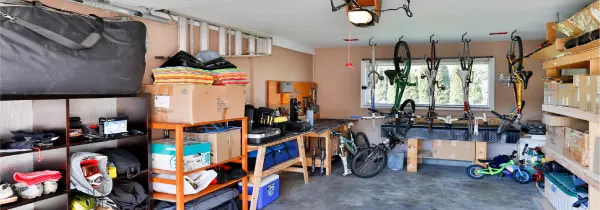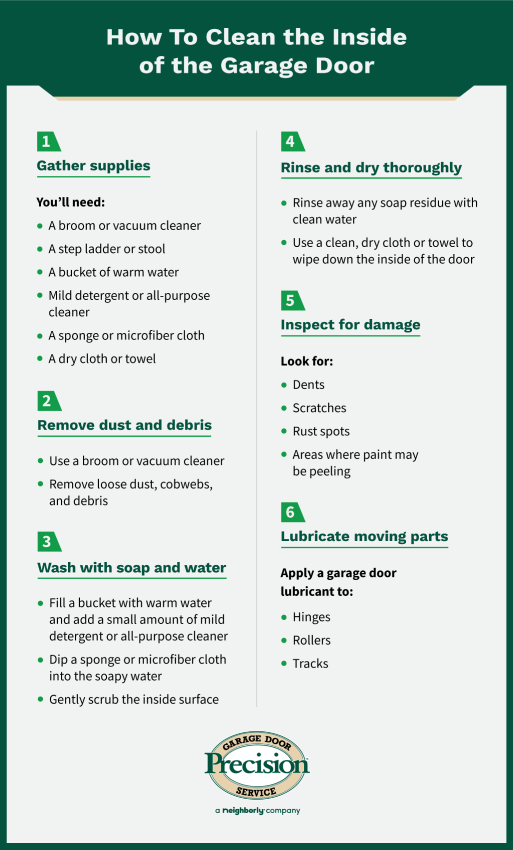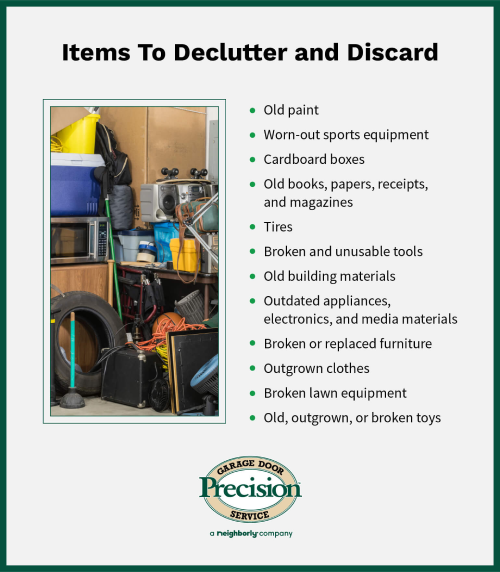
Whether you’re putting off your annual spring cleaning or you’re tired of searching high and low for your belongings, it’s time to clean the garage.
While a garage cleanout may sound daunting, it will only get worse if you don’t tackle it head-on. You may discover you only need to wipe off accumulated grime, or it could be as extensive as determining you need to repair your garage door.
Ready to clean the garage but unsure of where to begin? In our guide, we’ll walk through some tips, tricks, and steps to follow that will help you streamline the process.
Table of Contents:
- 1. Choose a Day When You Feel Motivated
- 2. Empty the Garage
- 3. Clean the Inside of the Garage Door
- 4. Repair, Replace, or Improve Spaces
- 5. Attack Odors
- 6. Clean All Surfaces
- 7. Tackle the Garage Floor
- 8. Invest in Garage Wall Storage
- 9. Use Sliding Shelves
- 10. Install Track Storage
- 11. Declutter and Discard Excess Items
- 12. Gather Loose Items
- 13. Organize the Back Entry
- 14. Create a Car Products Cabinet
- 15. Simplify Tool Storage
- 16. Hire Professionals
- Frequently Asked Questions
- Maintain Your Garage Door With Precision Garage Door Service
1. Choose a Day When You Feel Motivated
To prepare for your garage cleanout, choose a day when rain isn't in the forecast, and the temperature isn't too high or low. You want to clean the garage when the weather is mild and comfortable –– it's no fun lugging around your accumulated items in the blistering heat or on a wet, cold day.
To keep morale high, consider asking a family member, neighbor, or friend to assist in the garage cleanup project. The promise of a free lunch or dinner or returning the favor just might be enough to secure the help you need. Consult with friends and family to find a day that works for everyone.
Pro tip: To make the process go smoother, assign specific tasks to each helper and plan out the areas each person will tackle in advance. A little pre-planning will make the execution that much easier.
2. Empty the Garage
The trick to garage cleaning is to empty everything out so you have a clean slate. This helps you better assess the volume of stuff you're working with, which will result in a more efficient cleanout. Be sure to create categories for your belongings, including sports equipment, holiday decor, or seasonal gear. Having your items categorized in groups will help you organize and store them after you clean the garage.
Emptying the garage goes beyond removing your belongings — it also includes taking things off hooks, removing storage bins, and removing other loose miscellaneous items. Once your space is fully cleared out, you can envision the best place to store everything. This is where that pre-planning can help. Knowing how you want to store and access items will make putting them away easier.
3. Clean the Inside of the Garage Door

Now that you've cleared everything out, it's time to get to cleaning! Start with the inside of the garage door. It's not uncommon for your garage door to accumulate dust, dirt, and even cobwebs. Here's how to clean the inside of a garage door effectively:
- Gather supplies: Before you begin, gather the necessary supplies. For this project, you'll need a broom or shop-vac, a step ladder or stool (if necessary), a bucket of warm water, mild detergent or all-purpose cleaner, a sponge or microfiber cloth, and a dry cloth or towel for drying. You'll also need safety items, including gloves and eye protection, to protect yourself from debris, dirt, and even glass.
- Remove dust and debris: Start by using a broom or vacuum cleaner with a brush attachment to remove loose dust, cobwebs, and debris from the inside of the garage door. Focus on the corners, edges, and crevices where dirt and cobwebs tend to accumulate.
- Wash with soap and water: Fill a bucket with warm water and add a small amount of mild detergent or all-purpose cleaner. Dip a sponge or microfiber cloth into the soapy water. Start by gently scrubbing the inside surface –– start from the top to the bottom, and then side to side.
- Rinse and dry thoroughly: Once you've cleaned the entire surface of the garage door, rinse away any soap residue with clean water. Use a clean, dry cloth or towel to wipe down the inside of the door and remove any remaining moisture. Don't forget the areas that may collect water, including along the bottom edge or around hinges and tracks.
- Inspect for damage: Take this time to inspect the inside of the door for any signs of damage or wear. Look for dents, scratches, rust spots, or areas where paint may be peeling. Addressing these issues can help prevent further damage and prolong the lifespan of the door.
- Lubricate moving parts: If your garage door has moving parts such as hinges, rollers, or tracks, consider applying a lubricant to keep them operating smoothly. Use a silicone-based lubricant or garage door lubricant specifically designed for this purpose. Apply lubricant sparingly to avoid attracting dust and debris.
4. Repair, Replace, or Improve Spaces
.webp)
Now's the time to repair, replace, and improve any spaces in the garage. This is a great time to make these updates now that your garage is empty.
Here are a few projects to consider:
- Repair drywall
- Touch up paint
- Refinish surfaces
- Secure any loose shelves, hooks, or nails
- Repair damaged or exposed wires
- Change the lightbulbs
- Fix floor cracks
- Upgrade the floor (e.g., epoxy coating)
- Seal caulking
- Tune up the door mechanism
- Clean gutters near the garage
- Install power doors
- Replace or install shelving or other storage options
- Set up rodent traps
5. Attack Odors
Garages are notorious for developing unpleasant odors over time due to moisture, mold, mildew, chemicals, and little airflow. The garage is often a designated area for storing garbage, storage boxes, fuel for gas-powered lawn equipment, containers, and other items and can leave an unpleasant scent.
It's important to tackle icky odors during your garage cleanout. Make sure to clean any trash bins and storage containers. You can also use essential oils to help improve the scent. Deodorizers and even some baking soda can help absorb and eliminate these tough odors, but be sure to replace them regularly.
6. Clean All Surfaces
Aside from cleaning the garage door, you'll want to clean all surfaces. Start from the top and work your way to the bottom, going side to side. If you have a shop-vac, now is the time to put it to work. This will help minimize the amount of dust and debris in the air. If you don't have a shop-vac, use your trusty broom or duster, brush along the walls, storage containers, baseboards, and the floor to remove dust and debris. Bring out your mop to wash the garage floor. You can also use a pressure washer to make the floors even cleaner.
Here's how to clean other garage surfaces:
- Wipe down walls to remove dirt, grime, and stains.
- Vacuum or dust cobwebs on walls.
- Dust, vacuum, and wipe down all shelves and storage units.
- Wash tools and other household equipment.
- Remove dust and cobwebs from the ceiling and light fixtures.
- Wipe down light fixtures.
- Wipe down window frames and sills.
- Wash trash bins to disinfect and remove odors.
7. Tackle the Garage Floor
It's easy to forget to clean or maintain floors. This area often bears the brunt of spills, stains, and seasonal road salt and sand. After you sweep, vacuum, or pressure wash the floors, focus your attention on stains, spills, and cracks. Use a degreaser or floor cleaner with a stiff-bristled brush to remove stains. Apply a garage floor sealant to protect against future stains and damage.
Pro tip: Consider an epoxy floor finish, which is both durable and water-resistant.
Here are some common ways to care for the garage floor:
- Sweep and wash the floors
- Vacuum floor mats and rugs
- Apply a degreasing solution
- Scrub out stains
- Pressure wash the floors
- Apply a concrete sealer or epoxy coating
- Repair any cracks or holes
8. Invest in Garage Wall Storage
.webp)
As you clean the garage, you may notice a sudden need for additional storage. While you may not be able to add more square footage, you can get creative.
This is where garage wall storage becomes an invaluable option. Maximize vertical space by installing wall-mounted storage solutions such as shelves, cabinets, or pegboards. Wall storage not only helps keep items off the floor but also provides easy access to frequently used tools, supplies, tools, and even decor. Choose adjustable shelving units or modular storage systems to customize the layout according to your needs.
Here are a few garage wall storage ideas to maximize your space:
- Wall hooks
- Wire shelves
- Pegboards for small items
- Corner shelving units
- Tool racks
- Wall or ceiling bike racks
- Bins or baskets for sports equipment
- Overhead or ceiling shelves
9. Use Sliding Shelves
Sliding shelves are an excellent storage solution for cabinets or shelving units to maximize your garage space. This type of garage shelf glides in and out of cabinets smoothly, allowing you to access items stored at the back without having to rummage through cluttered shelves.
You can install sliding shelves for small tools, automotive supplies, or gardening equipment to streamline your organization and accessibility.
10. Install Track Storage
Track storage systems consist of a horizontal track mounted to the wall with adjustable hooks, bins, or baskets that can be repositioned as needed. This organization system provides flexible storage for items of various sizes and shapes, such as sports equipment, hoses, or power tools.
Install track storage along unused wall space to make the most of your garage's storage capacity while keeping the floor clear.
11. Declutter and Discard Excess Items

Garages are known for collecting and storing clutter. (Yes, we’re talking about that broken lamp you refuse to discard.) Take this time to declutter your garage and sort through your belongings. Make separate piles for items to keep, donate, sell, or throw away. You can also recycle, reuse, and compost your unwanted items.
Try to resist the temptation of holding onto items out of sentimentality or the very common “just in case.” Here are a few items to consider tossing:
- Old paint
- Worn-out sports equipment
- Cardboard boxes
- Old books, papers, receipts, and magazines
- Tires
- Broken and unusable tools
- Old building materials
- Outdated appliances, electronics, and media materials
- Broken or replaced furniture
- Outgrown clothes
- Broken lawn equipment
- Old, outgrown, or broken toys
When sorting through the items from your garage, use the same approach you would take when decluttering your home: sort items into three categories: keep, donate, discard. This will help you avoid cluttering the garage with items you don’t need or use anymore.
12. Gather Loose Items
We're all guilty of tossing miscellaneous items in the garage and then going on a scavenger hunt to find them again. As you clean the garage, you may come across the soccer cleats your kid was looking for or the winter coat your partner couldn't find for the latest holiday party. Focus this time on grouping loose items together instead of piling them on a shelf or stuffing them into a random bin.
13. Organize the Back Entry
Maximize your back entry space to serve as an essential spot for on-the-go items. Add a bench or shoe rack to store footwear, hang hooks to keep your keys, and set up a table for other essential items. Keeping this area clean can streamline your daily routine while preventing clutter from spilling into the rest of the garage.
14. Create a Car Products Cabinet
Designate a specific cabinet or storage area to store car maintenance products, including motor oil, windshield washer fluid, and cleaning supplies. Keep these items readily accessible but organized to prevent clutter and spills. Consider installing shelves, bins, or drawers to compartmentalize different types of products and keep them neatly arranged.
15. Simplify Tool Storage
If you perform a lot of household chores like gardening or routine maintenance, you’ll want to create a designated tool storage area. Not only will this simplified storage declutter your garage, but it will eliminate the headache and hassle of searching for your tools.
Invest in tool organizers, pegboards, or wall-mounted racks to keep tools sorted and easily accessible. Group similar tools together and arrange them in a logical order, perhaps by frequency of use or type of project. Consider labeling or color-coding storage areas to make it easy to locate specific tools at a glance.
16. Hire Professionals
If you're still unsure how to clean out a garage, consider hiring a team of professionals who specialize in organizing such spaces. These professionals will clean and organize your space, saving you the time and hassle, and provide a long-term garage cleanup solution.
Frequently Asked Questions About Garage Cleaning
Where Do I Start When Cleaning My Garage?
Start by choosing a day that works best for you and anyone who you have enlisted to help. Then, begin removing everything from your garage. Once you have a clean slate, you’ll be able to clean, organize, and declutter.
What Is the Best Way to Clean Out a Garage?
The best way to clean out a garage is by emptying everything out. You’ll then want to clean all surfaces, including the inside of the garage door. Once your workspace is clean, you can begin sorting and organizing your belongings.
Can You Pressure Wash the Garage Floor?
Yes, you can pressure wash the garage floor. In fact, this is one of the best ways to remove stubborn stains and grease from the garage floor. Make sure to use the appropriate cleaning solution for your type of garage floor. Also, don’t use excessive pressure, or you may damage the floors.
How Often Should I Clean the Garage?
Clean the garage at least once or twice a year. Be sure to conduct routine maintenance more often, including sweeping and decluttering, to keep the garage tidy.
Maintain Your Garage Door With Precision Garage Door Service®
Now that you’re more familiar with how to clean the garage, you’re ready to get started. Remember to choose a day with mild weather, and one that works for you and anyone who’s helping. Start by clearing everything out for a clean slate. Then, go in and wipe and wash all areas. Don’t forget to sort through your belongings and declutter (and actually toss or donate items).
A thorough garage cleanout tends to uncover other necessary maintenance. If you find that your garage door could use the same level of care, trust the professionals at your local Precision Garage Door Service for your garage door repair needs.
This article is intended for general informational purposes only and may not be applicable to every situation. You are responsible for determining the proper course of action for your property. Services should be performed by licensed and experienced professionals. Precision Garage Door Service is not responsible for any damages that occur as a result of this blog content or your actions. For the most accurate guidance, contact a Precision Garage Door Service professional for a custom, on-site assessment.